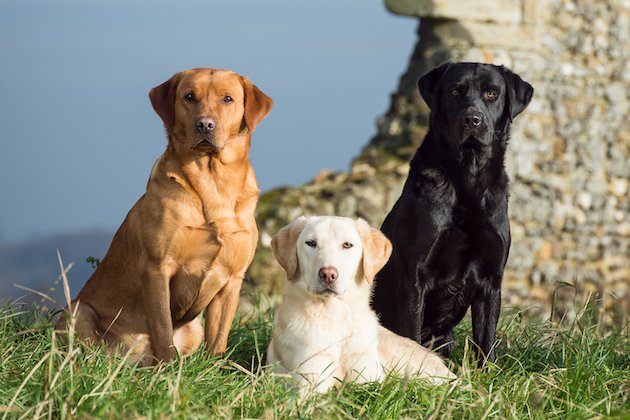Labrador Retrievers, with their wagging tails and friendly demeanor, have captured the hearts of dog lovers worldwide.
Often referred to simply as “Labs,” these versatile canines are celebrated for their intelligence, loyalty, and unwavering affection.
In this comprehensive guide, we’ll delve into the enchanting world of Labrador Retrievers, exploring their origins, unique characteristics, and the joys of sharing your life with one of these beloved companions.

1. Origin and History of Labrador Retrievers
Labrador Retrievers originated from the rugged coastlines of Newfoundland, Canada, where they were bred to assist fishermen in retrieving nets and hauling fishing lines from the icy waters.
Their innate swimming abilities, coupled with their strong work ethic and gentle disposition, made them invaluable assets to the fishing community.
Over time, Labrador Retrievers gained recognition for their versatility and were eventually brought to England, where they were refined and developed into the breed we know and love today.
2. Physical Characteristics
One of the most striking features of Labrador Retrievers is their distinctive coat, which comes in three primary colors: black, yellow, and chocolate.
Their double-layered coat provides insulation from harsh weather conditions, with a dense, water-resistant outer coat and a soft, insulating undercoat.
Labrador Retrievers are well-built, athletic dogs, with a sturdy frame and an expressive face adorned with kind, soulful eyes.
3. Temperament and Personality Traits
Labrador Retrievers are renowned for their friendly and outgoing nature, making them excellent companions for individuals and families alike.
They possess an innate eagerness to please and thrive on human interaction and companionship.
Labs are known for their boundless energy and enthusiasm, whether they’re playing fetch in the backyard or snuggling up on the couch for a cozy nap.
Their gentle demeanor and patience make them particularly well-suited for households with children and other pets.
4. Versatility in Roles and Activities
Labrador Retrievers excel in a variety of roles and activities, thanks to their intelligence, trainability, and adaptability.
They are commonly employed as service dogs, therapy dogs, search and rescue dogs, and even as skilled hunting companions.
Additionally, Labs enjoy participating in canine sports such as agility, obedience, and dock diving, where they can showcase their athleticism and agility.
Whatever the task or activity, Labrador Retrievers approach it with enthusiasm and gusto.

5. Training and Socialization
Early training and socialization are essential for shaping a Labrador Retriever’s behavior and temperament.
Begin obedience training as soon as you bring your puppy home, using positive reinforcement techniques such as treats, praise, and consistent commands.
Socialize your Labrador with people, animals, and various environments to ensure they grow into well-adjusted and confident adults.
With patience, consistency, and plenty of praise, you’ll soon find that your Labrador is eager to learn and please.
6. Exercise and Activity Requirements
Labrador Retrievers are energetic and athletic breeds that require regular exercise and stimulation to thrive.
Aim for at least 60 minutes of physical activity per day, which can include brisk walks, jogging, hiking, or interactive play sessions.
Engage your Labrador in activities that tap into their natural instincts, such as retrieving games or scent work, to keep them mentally and physically stimulated.
A tired Labrador is a happy Labrador, so be sure to provide ample opportunities for exercise and enrichment.
7. Grooming and Coat Care
Maintaining a regular grooming routine is essential for keeping your Labrador’s coat healthy and free of tangles.
Brush their coat at least twice a week to remove loose fur and prevent matting, paying particular attention to their undercoat during shedding seasons.
Bathe your Labrador as needed, using a mild dog shampoo to avoid stripping their skin of natural oils.
Additionally, trim their nails regularly, clean their ears, and brush their teeth to promote good overall hygiene.
8. Common Health Issues
While Labrador Retrievers are generally healthy dogs, they are prone to certain genetic health issues, including hip dysplasia, elbow dysplasia, and progressive retinal atrophy.
Regular veterinary check-ups are essential for monitoring your Labrador’s health and detecting any potential issues early on.
Maintain a healthy weight through proper nutrition and regular exercise to reduce the risk of obesity-related health problems.
Conclusion: Embracing the Joys of Labrador Ownership
In conclusion, Labrador Retrievers possess a unique charm and charisma that endears them to dog lovers around the world.
Whether as a loyal companion, a working partner, or a beloved family pet, Labs enrich our lives with their unwavering loyalty, boundless energy, and infectious enthusiasm.
By understanding their origins, embracing their versatile nature, and providing them with love, care, and attention, you’ll unlock the true charm of Labrador Retrievers and experience the joys of canine companionship like never before.

FAQs (Frequently Asked Questions):
Do Labrador Retrievers shed a lot?
Labrador Retrievers do shed, especially during seasonal changes.
Regular grooming can help minimize shedding and keep their coat healthy and shiny.
Are Labrador Retrievers good with children?
Yes, Labrador Retrievers are known for their gentle and friendly nature, making them excellent companions for children when properly socialized and supervised.
How much exercise does a Labrador Retriever need?
Labrador Retrievers require at least 60 minutes of moderate to vigorous exercise per day to stay healthy and happy.
Activities such as walking, jogging, and playing fetch are ideal.
Are Labrador Retrievers easy to train?
Yes, Labrador Retrievers are highly trainable and eager to please.
Consistent training using positive reinforcement techniques yields excellent results.
What is the average lifespan of a Labrador Retriever?
The average lifespan of a Labrador Retriever is typically 10 to 12 years, although with proper care and attention, some may live even longer.

